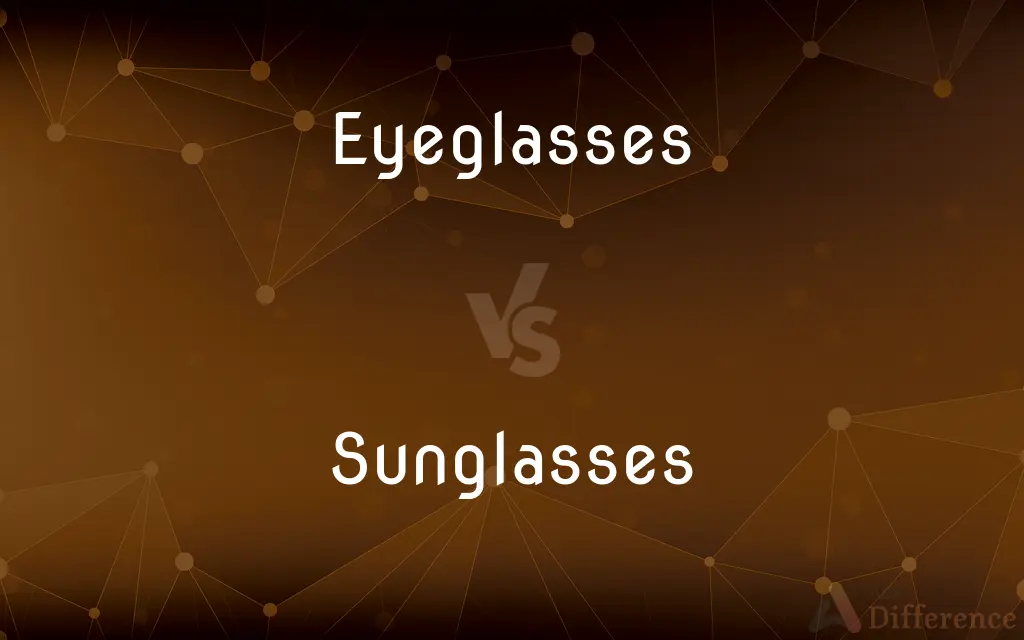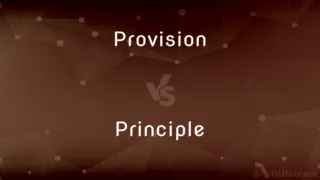Eyeglasses vs. Sunglasses — What's the Difference?
Edited by Tayyaba Rehman — By Urooj Arif — Updated on April 1, 2024
Eyeglasses correct vision with prescription lenses, while sunglasses protect eyes from UV light and glare with tinted lenses.

Difference Between Eyeglasses and Sunglasses
Table of Contents
ADVERTISEMENT
Key Differences
Eyeglasses, designed primarily for vision correction, utilize prescription lenses to address issues like myopia, hyperopia, and astigmatism. On the other hand, sunglasses are equipped with tinted lenses that reduce glare and protect the eyes from harmful ultraviolet (UV) rays, focusing on eye health and comfort in bright environments.
While eyeglasses serve a functional purpose in improving vision clarity, sunglasses add an additional layer of protection against external elements, such as UV light and bright sunlight, which can cause discomfort and long-term eye damage. This distinction highlights how each type of eyewear caters to different needs: vision correction versus environmental protection.
The materials used in eyeglasses and sunglasses can vary widely. Eyeglasses often emphasize clarity and durability in their lenses, with options for anti-reflective and scratch-resistant coatings. Whereas sunglasses may prioritize UV protection and polarization in their lenses to offer enhanced visual comfort and protection in various lighting conditions.
In terms of fashion and personal style, sunglasses offer a wide range of styles, colors, and designs, reflecting personal taste and lifestyle needs. Eyeglasses, while also available in numerous styles, are often chosen with a focus on comfort and fit for everyday wear, considering the wearer's face shape and prescription needs.
Both eyeglasses and sunglasses can feature specialized lenses, such as photochromic lenses, which darken in response to sunlight, bridging the gap between vision correction and sun protection. This adaptability demonstrates the evolving nature of eyewear technology to meet a combination of functional and aesthetic preferences.
ADVERTISEMENT
Comparison Chart
Primary Function
Correct vision with prescription lenses.
Protect eyes from UV light and glare with tinted lenses.
Lens Features
Prescription-based, may include anti-reflective or scratch-resistant coatings.
Tinted for glare reduction, often UV-protective and polarized.
Purpose
Improve vision clarity for those with visual impairments.
Protect eyes against sunlight, glare, and UV rays for comfort and health.
Material Focus
Clarity and durability in lens materials.
UV protection and polarization in lens materials.
Style and Personalization
Wide range of frames for comfort and aesthetic, influenced by facial shape and prescription.
Diverse styles, colors, and designs reflecting personal taste and lifestyle.
Compare with Definitions
Eyeglasses
Often used daily by individuals with vision impairments.
He puts on his eyeglasses first thing in the morning to see clearly.
Sunglasses
Essential for outdoor activities to prevent eye discomfort.
She wears sunglasses while hiking to shield her eyes from harsh sunlight.
Eyeglasses
Optical devices with prescription lenses to correct vision.
She wears eyeglasses to correct her nearsightedness.
Sunglasses
Eyewear with tinted lenses to protect from sunlight and UV rays.
He never forgets his sunglasses on a sunny day to protect his eyes.
Eyeglasses
May include bifocals or multifocals for multiple vision corrections.
Her bifocal eyeglasses help with both reading and distance vision.
Sunglasses
Lenses can be polarized to reduce glare from reflective surfaces.
Her polarized sunglasses make it easier to drive by reducing glare.
Eyeglasses
Frames come in various shapes to suit face structure.
Choosing round eyeglasses frames complements her square face shape.
Sunglasses
Fashion statements that come in various styles and colors.
His aviator sunglasses add a touch of style to his summer wardrobe.
Eyeglasses
Can feature anti-reflective coatings for reduced glare.
His new eyeglasses have an anti-reflective coating for better night driving.
Sunglasses
Can have photochromic lenses that adjust to light conditions.
His sunglasses darken automatically in sunlight, providing constant protection.
Eyeglasses
Eyeglasses Glasses for the eyes.
Sunglasses
Sunglasses or sun glasses (informally called shades or sunnies; more names below) are a form of protective eyewear designed primarily to prevent bright sunlight and high-energy visible light from damaging or discomforting the eyes. They can sometimes also function as a visual aid, as variously termed spectacles or glasses exist, featuring lenses that are colored, polarized or darkened.
Eyeglasses
A single lens in a pair of glasses; a monocle.
Sunglasses
A convex lens used to focus the sun's rays and produce heat, especially for ignition.
Eyeglasses
See eyepiece.
Sunglasses
Sunglasses Eyeglasses with tinted or polarizing lenses to protect the eyes from the sun's glare.
Eyeglasses
See eyecup.
Sunglasses
Tinted glasses worn to protect the eyes from the sun.
Eyeglasses
(US) Spectacles, glasses.
Sunglasses
(colloquial) A person wearing sunglasses
Eyeglasses
A pair of lenses fixed together in a frame, used for correcting defective vision. Also called a pair of eyeglasses. See also eyeglass{1}.
Sunglasses
Spectacles that are darkened or polarized to protect the eyes from the glare of the sun;
He was wearing a pair of mirrored shades
Eyeglasses
Optical instrument consisting of a pair of lenses for correcting defective vision
Common Curiosities
What is the significance of UV protection in sunglasses?
UV protection in sunglasses is crucial to prevent eye damage from the sun’s harmful ultraviolet rays.
Can eyeglasses and sunglasses have the same style frames?
Yes, both eyeglasses and sunglasses can come in a variety of styles and frames, catering to personal tastes and needs.
Are there eyeglasses that can also function as sunglasses?
Yes, photochromic lenses in eyeglasses darken in response to sunlight, serving both vision correction and sun protection purposes.
Can I get prescription sunglasses?
Yes, sunglasses can be fitted with prescription lenses, combining vision correction with sun protection.
How do I know if my eyeglasses have UV protection?
Eyeglasses with UV protection will be labeled as such; it's important to ask your optometrist or eyewear provider for this feature.
How often should I replace my sunglasses?
Replace your sunglasses if the lenses are scratched or damaged, or if they no longer offer adequate UV protection.
Can I wear sunglasses indoors?
While you can wear sunglasses indoors, it may reduce visibility and is generally unnecessary unless for specific light sensitivity issues.
How do sunglasses protect the eyes?
Sunglasses protect the eyes from harmful UV rays and reduce glare with their tinted and often polarized lenses.
Are sunglasses necessary on cloudy days?
Yes, sunglasses are recommended on cloudy days as UV rays can penetrate clouds, posing a risk to eye health.
What are eyeglasses used for?
Eyeglasses are used to correct vision issues such as myopia, hyperopia, and astigmatism with prescription lenses.
Do all sunglasses offer 100% UV protection?
Not all sunglasses offer 100% UV protection; it’s essential to check the product specifications for this feature.
Is it important to have anti-reflective coating on eyeglasses?
An anti-reflective coating on eyeglasses can reduce glare from lights, making it easier to see and reducing eye strain.
Why might someone choose polarized sunglasses?
Polarized sunglasses are chosen for their ability to reduce glare from surfaces like water and roads, improving visual comfort.
Can wearing eyeglasses too much weaken my eyes?
No, wearing eyeglasses as prescribed will not weaken your eyes; they correct your vision and are necessary for optimal sight.
Why are there different lens colors in sunglasses?
Different lens colors in sunglasses can enhance contrast, improve visual clarity, and offer aesthetic choices, tailored to various activities and preferences.
Share Your Discovery

Previous Comparison
Engaging vs. Engaged
Next Comparison
Provision vs. PrincipleAuthor Spotlight
Written by
Urooj ArifUrooj is a skilled content writer at Ask Difference, known for her exceptional ability to simplify complex topics into engaging and informative content. With a passion for research and a flair for clear, concise writing, she consistently delivers articles that resonate with our diverse audience.
Edited by
Tayyaba RehmanTayyaba Rehman is a distinguished writer, currently serving as a primary contributor to askdifference.com. As a researcher in semantics and etymology, Tayyaba's passion for the complexity of languages and their distinctions has found a perfect home on the platform. Tayyaba delves into the intricacies of language, distinguishing between commonly confused words and phrases, thereby providing clarity for readers worldwide.













































